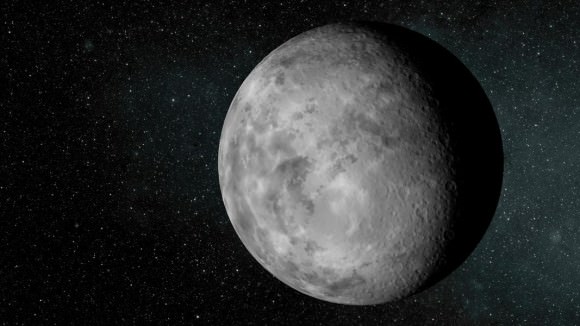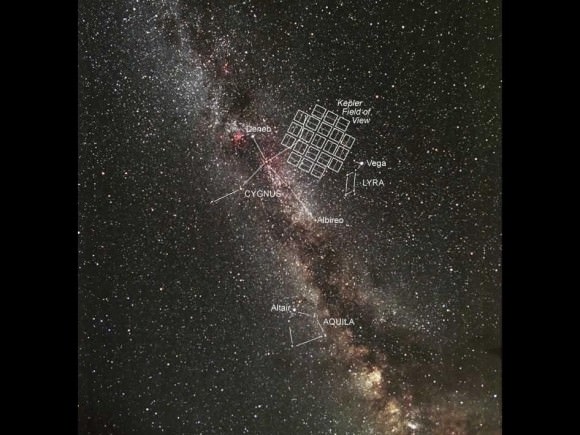Scientists have discovered a new planet orbiting a Sun-like star, and the exoplanet is the smallest yet found in data from the Kepler mission. The planet, Kepler-37b, is smaller than Mercury, but slightly larger than Earth’s Moon. The planet’s discovery came from a collaboration between Kepler scientists and a consortium of international researchers who employ asteroseismology — measuring oscillations in the star’s brightness caused by continuous star-quakes, and turning those tiny variations in the star’s light into sounds.
“That’s basically listening to the star by measuring sound waves,” said Steve Kawaler, from Iowa State University in the US, and a member of the research team. “The bigger the star, the lower the frequency, or ‘pitch’ of its song.”
The measurements made by the astroseismologists allowed the Kepler research team to more accurately measure the tiny Kepler-37b, as well as revealing two other planets in the same planetary system: one slightly smaller than Earth and one twice as large.
While Kepler 37b is likely a rocky planet, this would not be a great place for humans to live. It’s likely very hot — with a smoldering surface and no atmosphere.
“Owing to its extremely small size, similar to that of the Earth’s moon, and highly irradiated surface, Kepler-37b is very likely a rocky planet with no atmosphere or water, similar to Mercury,” the team wrote in their paper, which was published this week in Nature. “The detection of such a small planet shows for the first time that stellar systems host planets much smaller as well as much larger than anything we see in our own Solar System.”
The host star, Kepler-37, is about 210 light-years from Earth in the constellation Lyra. All three planets orbit the star at less than the distance Mercury is to the Sun, suggesting they are very hot, inhospitable worlds. Kepler-37b orbits every 13 days at less than one-third Mercury’s distance from the Sun. The estimated surface temperature of this smoldering planet, at more than 800 degrees Fahrenheit (700 Kelvin), would be hot enough to melt the zinc in a penny. Kepler-37c and Kepler-37d, orbit every 21 days and 40 days, respectively.

NASA/Ames/JPL-Caltech
The size of the star must be known in order to measure the planet’s size accurately. To learn more about the properties of the star Kepler-37, scientists examined sound waves generated by the boiling motion beneath the surface of the star.
“The technique for stellar seismology is analogous to how geologists use seismic waves generated by earthquakes to probe the interior structure of Earth,” said Travis Metcalfe, who is part of the Kepler Asteroseismic Science Consortium.
The sound waves travel into the star and bring information back up to the surface. The waves cause oscillations that Kepler observes as a rapid flickering of the star’s brightness. The barely discernible, high-frequency oscillations in the brightness of small stars are the most difficult to measure. This is why most objects previously subjected to asteroseismic analysis are larger than the Sun.
“Studying these oscillations been done for a long time with our own Sun,” Metcalfe told Universe Today, “but the Kepler mission expanded that to hundreds of Sun-like stars. Kepler-37 is the coolest star, as well as the smallest star that has been measured with asterosiesmology.”
Kepler-37 has a radius just three-quarters of the Sun. Metcalfe said the radius of the star is known to 3 percent accuracy, which translates to exceptional accuracy in the planet’s size.
Metcalfe launched a non-profit organization to help raise research funds for the Kepler Asteroseismic Science Consortium. The Pale Blue Dot Project allows people to adopt a star to support asteroseismology, since there is no NASA funding for asteroseismology.
“Much of the expertise for this exists in Europe and not in the US, so as a cost saving measure NASA outsourced this particular research for the Kepler mission,” said Metcalfe, “and NASA can’t fund researchers in other countries.”
Find out how you can help this research by adopting one of the Kepler stars at the Pale Blue Dot Project website.
The Kepler spacecraft carries a photometer, or light meter, to measure changes in the brightness of the stars it is focusing on in the Cygnus region in the sky.

Metcalfe said this discovery took a long time to verify, as the signature of this very small exoplanet was hard to confirm, to make sure the signature wasn’t coming from other sources such as an eclipsing binary star.
Kawaler said Kepler is sending astronomers photometry data that’s “probably the best we’ll see in our lifetimes,” he said, adding that this latest discovery shows “we have a proven technology for finding small planets around other stars.”
“We uncovered a planet smaller than any in our solar system orbiting one of the few stars that is both bright and quiet, where signal detection was possible,” said Thomas Barclay, lead author of Nature paper. “This discovery shows close-in planets can be smaller, as well as much larger, than planets orbiting our sun.”
And are there more small planets like this out there, just waiting to be found?
As the team wrote in their paper, “While a sample of only one planet is too small to use for determination of occurrence rates it does lend weight to the belief that planet occurrence increases exponentially with decreasing planet size.”
Sources: phone interview with Travis Metcalfe, Iowa State University, NASA/JPL


Interesting. This find shows that smaller rocky exoplanets are a possibility, not just super Earths. Could we see dips in the star’s light caused by Earth like exoplanets (that theoretically exist in the habitable zone) or at that distance they don’t even disturb the light coming from the star?
Yes we can, but…
Bodies orbiting close to the star are:
1) More likely to pass in front of it
2) If they pass in front, they pass in front much more often (short orbital period)
This makes this kind of detection easier for bodies close to the star than those further away, i.e. detection of bodies far away requires longer timespans.
There most likely many-many planets yet to discover that simply have not had sufficient time yet to be detected.
How many passes should a planet take before it can be considered as a possibility?
Both the transit and the wiggle (doppler shift from gravitational tugging) method uses 3 periods of the signal to detect candidates with a reasonable likelihood.
Kind of remind me of Fleming’s “Once is happenstance. Twice is coincidence. Three times, it’s enemy action.”
Thank you for the answer.
Ok, I’m confused. This article doesn’t actually explain how these planets were discovered.
“asteroseismology — measuring oscillations in the star’s brightness caused by continuous star-quakes, and turning those tiny variations in the star’s light into sounds”
How do these planets impact the oscillations of this star? What is it that the asteroseismologists are detecting that indicate there are planets?
Astroseismology is a process of detecting variation in the brightness of a star, and it is used particularly with the sun, to back out what types of acoustical or seismic waves are present in the star. In the case of the sun the variation in brightness across the surface of the sun has been used to detect the convection and motion of material interior to the sun. With a distant star all you have is just the variation in brightness.
Here the variation in brightness was found to be very regular and Newton’s laws were used to compute the motion of a putative planet. The plausible conclusion is the existence of this planet. if the variation in brightness should suddenly change so the periodicity shifts it would falsify the hypothesis that this planet exists.
LC
Thanks for the explanation. Lets see if I understand. So, the planets are causing the particular oscillation that they detected in this star (presumably because their gravity is tugging on the star), whereas stars can oscillate for other reasons as well? Is this a new method of detecting planets?
Hi Kawarthajon, perhaps the following will clarify things. I read the Nature article and the planets were discovered by Kepler via the transit method, not asteroseismology. In other words, as the planets revolved around the host star (designated Kepler-37) they blocked incoming light from the host star, which was recorded by Kepler as dips in the host star’s lightcurve. The asteroseismology comes into play by providing precise fundamental parameters for the host star, including the radius. By knowing the radius of the host star, and the ‘transit profile’ that the planets caused as they orbited the host star, one can estimate the radius of the three planets. If one doesn’t know the radius of the host star well, then the subsequent parameters inferred for the orbiting planets are poorly constrained (hence the advantage of the asteroseismology approach). Anyways, the three planets were found to exhibit 0.3, 0.7, and 2 Earth-radii, respectively. Admittedly, although the transit lightcurves for the larger two planets appear convincing, there is considerable scatter for the smallest planet, and ultimately it requires continued monitoring for follow-up confirmation. In the Nature article they provide transit lightcurves for the objects in their Figure 1. Nevertheless, the study is a welcomed breakthrough.
Dan.
Thanks Dan. So the title, “Smallest Exoplanet Yet Discovered by ‘Listening’ to a Sun-Like Star”, isn’t that accurate. Listening to the star helped define the parameters of the star (and, therefore, the planet) but was not responsible for actually discovering it. That helps to clarify things. Jon
Hi Kawarthajon, no problems. Well, the title is accurate in the sense that one could argue that if asteroseismology wasn’t involved, the uncertainties may (I’m unsure) have been too large to confirm whether the smaller planet detected was indeed 0.303+-0.060 Earth radii. Perhaps it would have been 0.3+-1 Earth radii without asteroseismology, so in that case they couldn’t advocate that they found the smallest planet yet detected, because the uncertainty implies it could also be an Earth-sized planet.
Dan.